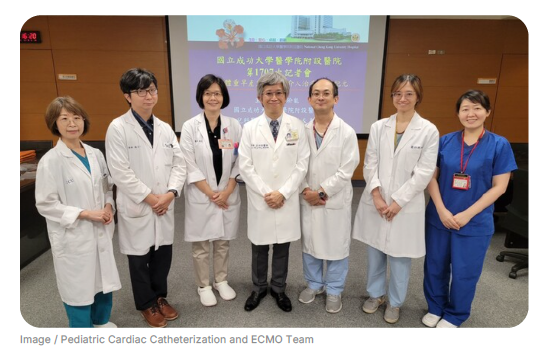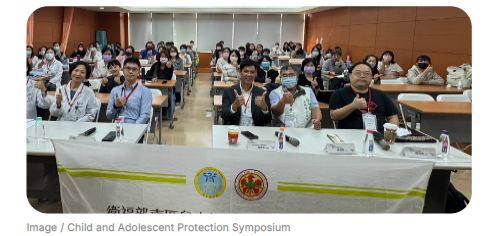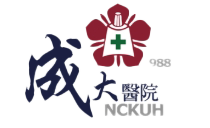Optimization of Pediatric Medical Care
Safeguarding Pregnant Women and Newborns
-
Designated Hospital for High-Risk Pregnancy
According to World Health Organization (WHO) data, approximately 810 women worldwide die each day from preventable pregnancy- and childbirth-related complications, and about 6,700 newborns die daily. In Taiwan, a nation facing declining birthrates and an aging population, “ensuring the safety of mothers and newborns” is one of the Hospital’s key goals.
NCKU Hospital has long served as a severe-level emergency responsibility hospital under the emergency medical capability grading system. It is also designated as a high-risk pregnancy responsibility hospital within the perinatal emergency medical network. Each year, deliveries at the Hospital account for approximately 6% of all births in Tainan City, with most of the maternity patients being high-risk pregnancies. Over the past five years, high-risk pregnancies have accounted for 64–73%, and emergency high-risk pregnancies for 5–7%.
The medical and nursing teams from the Department of Obstetrics and Gynecology – Maternal-Fetal Medicine Division – and the Department of Pediatrics – Neonatology Division – jointly convene regular perinatal team meetings to discuss and study medical treatment and care processes for high-risk pregnant women and newborns. Through more than ten years of tireless dedication, the team has become a reliable support for high-risk pregnant women and newborns (including premature infants), while also sharing its experience with other OB/GYN and pediatric medical institutions to collectively improve the quality of maternal and newborn care.
The Hospital possesses exceptional capability in promptly managing emergency high-risk pregnancies. Drawing on the experience of the trauma team, a “Postpartum Hemorrhage (PPH) Referral Protocol” has been established. Upon receiving referral notifications from other hospitals, the triage unit immediately activates the PPH group call, summoning personnel from the Department of Obstetrics and Gynecology, Emergency Department, Department of Anesthesiology, Blood Bank, Operating Room, Department of Medical Imaging, and ICU physicians or on-duty staff to the emergency department to prepare. This enables the immediate initiation of cross-disciplinary team responses to address the patient’s critical condition. Emergency physicians maintain the patient's vital signs, and an OB-GYN specialist begins treatment within 60 minutes of arrival. The Hospital is also capable of handling emergency high-risk pregnancies during nighttime and holidays, and can perform emergency deliveries and cesarean sections during nighttime hours.
In addition, with advances in medical technology, the Da Vinci Surgical System has been adopted by the Hospital’s Department of Obstetrics and Gynecology. This is particularly beneficial for surgeries involving deep pelvic anatomical structures. Paired with an advanced surgical platform and high-resolution imaging capabilities, the system offers superior stability and flexibility compared to traditional laparoscopy, enabling more precise and successful surgical outcomes.
-
Preterm Infant Intensive Care
The number of newborns in Taiwan has continued to decline annually; however, due to various factors such as advanced maternal age, the rate of preterm births has not decreased but rather increased. Over the past four years, the Department of Pediatrics' Division of Neonatology has cared for more than 700 preterm infants with birth weights under 2,500 grams, averaging 170–180 preterm births per year. Half of these babies weigh less than 1,500 grams and, due to immature organ systems, commonly experience complications such as respiratory distress, unstable body temperature, and fluid loss, thus requiring especially meticulous care.
Through close cooperation between the Neonatal Intensive Care Unit (NICU) and delivery room nurses, the Hospital has improved the heating equipment on neonatal resuscitation tables, pre-warmed delivery kits, and optimized postnatal neonatal care procedures. These measures have effectively reduced the incidence of hypothermia within the first hour of life among preterm infants, earning recognition as a merit award in the 2017 National Medical Quality Award (NHQA) Thematic Improvement Elite Group. Furthermore, in 2021, the Hospital was recognized at the Taiwan Neonatal Healthcare Network Annual Conference for achieving the lowest mortality and morbidity rates among medical centers.
With advances in medical technology, the global threshold of viability for preterm infants has lowered to 22 weeks’ gestation. In 2019, the Hospital successfully cared for a preterm infant born at 23 weeks’ gestation with a birth weight of only 421 grams until discharge. In 2022, the Hospital again delivered a preterm infant born at 23 weeks weighing just 351 grams. After nearly 200 days of meticulous care by the obstetrics and pediatrics teams, the baby’s weight increased tenfold to over 3,700 grams and was successfully discharged in early 2023. The child is now under continuous follow-up by NCKU Hospital’s Preterm Infant Follow-Up Team until age five.

It is worth noting that feeding preterm infants with breast milk during the period from two weeks to two months after birth is crucial in preventing necrotizing enterocolitis, a dangerous and potentially fatal condition. However, not all mothers of preterm infants are able to produce enough breast milk after childbirth to feed their babies. Therefore, in 2017, with subsidies from the Health Promotion Administration of the Ministry of Health and Welfare, NCKU Hospital established Taiwan’s second human milk bank—the Southern Human Milk Bank—taking on the responsibility of safeguarding the health of newborns(preterm infants) in southern and eastern Taiwan. To date, it has served thousands of recipients. In 2021, under the theme “The Deepest Love is Milk, as Precious as a Mother’s Own,” the milk bank received the SNQ National Quality Label from the Institute for Biotechnology and Medicine Industry in the Hospital Community Services category. Since 2022, it has continued to develop powdered human milk products from donated breast milk to support families who face difficulties in accessing frozen donor milk.
Pediatric Medical and Integrated Services
-
Pediatric Medical Research
The Department of Pediatrics was established in 1988 at the founding of the Hospital. It has continuously expanded in terms of personnel and equipment, and has earned recognition from various sectors in the areas of medical services, teaching internships, and academic research. The department collaborates with top international medical institutions in conducting medical research, focusing on in-depth understanding and investigation of pediatric diseases, and upholds the research mission of “ensuring favorable health outcomes and improving quality of life for children,” promoting close integration between clinical and basic research. Currently, the department has established multiple research teams, including the Neonatal Neurology Team, Genetic and Rare Disease Team, Asthma and Immunology Team, Enterovirus Team, Nephrology and Dialysis Team, Cancer and Bone Marrow Transplantation Team, Cardiac Catheterization and ECMO Team, Hepatobiliary and Gastrointestinal Endoscopy Team, and the Premature Infant Care Team.
There is a “ductus arteriosus” connecting the aorta and the pulmonary artery in a fetus. Normally, this duct closes spontaneously within 2 to 3 days after birth in full-term infants. If it remains open, it leads to a condition known as “patent ductus arteriosus” (PDA), which can cause pulmonary edema, pulmonary hemorrhage, heart failure, and even become life-threatening. The occurrence rate of PDA increases significantly in preterm infants with lower gestational age and birth weight, averaging as high as 30-40%.
“Minimally invasive catheter closure surgery” is a common interventional treatment for larger infants over 3 kilograms. However, it is highly challenging in extremely low birth weight preterm infants due to their extremely small blood vessels and susceptibility to hypothermia. Nonetheless, the pediatric team at NCKU Hospital is confident in managing various PDA-related respiratory symptoms. The team has successfully treated a preterm infant born at 26+3 weeks of gestation with a birth weight of 766 grams—after undergoing cardiac catheterization, the infant was able to be removed from the ventilator just two days post-surgery. Another case involved a male infant born at 22+4 weeks of gestation weighing only 462 grams, who also successfully underwent cardiac catheterization. This represents the lowest birth weight recorded in the literature for such a procedure.

The NCKU Hospital team has published four related papers in SCI journals. In addition to case reviews and experience sharing, the publications also include the use of a unique umbilical intervention for treating patent ductus arteriosus in preterm infants and a comparison of post-operative respiratory trajectories in preterm infants undergoing either catheterization or surgical ligation. In 2023, the team published a paper in the journal Pediatric Pulmonology of the American Thoracic Society, exploring the association between bronchopulmonary dysplasia at discharge and various treatment modalities. The team has also been invited multiple times to present at international conferences or online meetings and has collaborated and co-authored papers with world-leading teams to showcase Taiwan’s achievements.
-
Child Development and Protection
Since 1997, the Hospital has been commissioned by the Department of Health, Executive Yuan, to serve as a model hospital for the “Child Developmental Joint Assessment Center.” The Center targets high-risk infants and young children aged 0 to 6 years with developmental delays or suspected delays, identifying the type and extent of the delay, formulating individualized treatment goals, and referring them to appropriate institutions for treatment. For children undergoing treatment, the Center conducts regular follow-up assessments, supports other hospitals with specialized examinations, and assists children with developmental delays in returning to mainstream society, thereby fulfilling the medical service principle of “early detection, early intervention.”
In 2018, in response to the Executive Yuan’s “Strengthening the Social Safety Net Program,” the Hospital established the “Regional Medical Integration Center for Child and Adolescent Protection,” actively collaborating with the Tainan City Government’s Social Affairs Bureau, Domestic Violence Prevention Center, Taiwan Tainan District Court, and the District Prosecutors Office. In the event of serious child abuse cases, coordination meetings are convened to jointly discuss follow-up handling plans and assist in the identification and assessment of injuries in child and adolescent protection cases, as well as in the physical and psychological recovery of abused children and adolescents.

Each year, the Hospital organizes more than ten educational training sessions and seminars on related topics, extending cooperation to civil social welfare organizations and jointly holding the “4/28 Child Protection Day” advocacy event with the Taiwan Fund for Children and Families. The Hospital has also launched the “Home Visit Assessment Program for Children and Adolescents in Vulnerable Families,” targeting families served by Tainan City Social Welfare Service Centers. Upon social worker assessment identifying children with multiple needs in the household, referrals are made to the Hospital’s Child Protection Integration Center, which arranges for a medical team to conduct home visits. If any issues related to health, medical care, developmental delay, or caregiving are found, the team provides consultation and referral services, enabling early detection and intervention.


